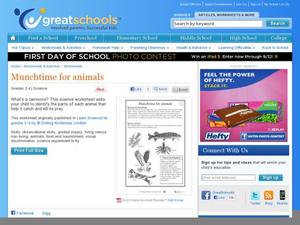Curated OER
Bite on This!
Different types of teeth have different roles. Third graders study how molars, incisors, and canines function in a rabbit skull and a cat skull. After answering some questions about the teeth of herbivores and carnivores, kids...
Curated OER
Dinnertime for Animals
Is a deer an herbivore? What about a spider? Experiment with the food chain in an interactive science experiment. After listing the herbivores from a selection of animals, third and fourth graders compare the skulls and teeth of...
Curated OER
A Tooth for a Tooth
Learners classify mammals as carnivores or herbivores. They look at a set of pictures of animal skulls, observing the shape and size of the teeth, and identify herbivores and carnivores.
Curated OER
Carnival of Carnivores
Students research different species of meat-eating animals in their natural environments to create a Carnival of Carnivores exhibit for their classroom.
Curated OER
Food chains at sea
Fifth graders interpret a table of data about food chains in the ocean. They create a food chain to represent the information on the table. Periwinkles eat seaweed, and crabs eat periwinkles - so who eats crabs? Extend the activity with...
Curated OER
Munchtime for animals
Which animals eat meat to stay alive? Third graders group fish, hawks, and cats into carnivores and herbivores. An extended activity prompts kids to cut out magazine pictures of different animals according to the foods that they eat.
It's About Time
Who Eats Whom?
Packed with visual aids and multiple learning opportunities, an engaging exercise challenges individuals as they explore the role of producers, consumers, and decomposers. After discussing differences between food chains, food...
Chicago Botanic Garden
Leaf Litter Ecology Lab
Some organisms spend their entire lives in leaf litter. The third in a series of six is a great lesson exploring the community of leaf litter. Groups gather and then spread leaf litter over white paper and remove leaves/twigs while...
Curated OER
Compare and Contrast
In this making connections worksheet, students compare and contrast herbivores and carnivores. Students use a graphic organizer to organize their information.
Curated OER
Animal Skulls
Pictures of different animal skulls make this slide show fascinating. The intent is to display the differences in structure among herbivores, carnivores, and omnivores. If you do not have animal skull replicas, this presentation would be...
Curated OER
The Food Chain
For this food chain worksheet, students draw a food chain plus describe and name an omnivore, herbivore, and carnivore. Students answer nine questions.
Curated OER
Food Chains
Have your class discuss food chains using this presentation. This resource goes through a step by step exploration of plants and the food chain. It talks about the energy of the sun, producers and consumers, herbivores and carnivores,...
Curated OER
Food Chains
One of the topics elementary school kids love to study is the concept of a food chain. This presentation provides a basic overview of the food chain. It also has definitions for herbivore, carnivore, and omnivore. However, there is only...
Statistics Education Web
The Case of the Careless Zookeeper
Herbivores and carnivores just don't get along. Using a box of animal crackers, classes collect data about the injury status of herbivores and carnivores in the box. They complete the process of chi-square testing on the data from...
Curated OER
Animal Groups
This animal science PowerPoint allows students to investigate types of animal groups. The slides contain clear information about herbivores and carnivores and explains their diet. This is a great way to introduce animal groups to students.
Curated OER
Nutritional Relationships Chart
Producers, Herbivores, Carnivores, Decomposers, oh my! Help organize the intricacies between these four types of eaters with this biology worksheet. Scientists display nutritional relationships in a graphic organizer. They place 15 terms...
Curated OER
Aquatic Food Webs
Students discuss producers, herbivores, omnivores, carnivores, and decomposers and analyze the difference between food chains and food webs. They participate in a food web yarn game, examining what can effect the breakdown of the web.
Desert Discoveries
What's For Dinner?
Youngsters compare the teeth of plant-eating dinosaurs with those of meat-eating dinosaurs. The concepts of herbivore vs. carnivore are also introduced. There is an excellent worksheet embedded in the plan which shows five skulls of...
Desert Museum
Daisy Ecology
Here's a fine activity that combines poetry with life sciences. Learners carefully listen to a poem that's all about a food chain. As the poem is read, learners name the producer, the herbivore, the carnivore, and the omnivore. Lots of...
Curated OER
Animal Nutrition, Variations, Adaptations & Regulation
Information about digestion of various food components is given in this PowerPoint. The diets of herbivores and carnivores are compared, and there are many diagrams giving details of their digestive system specializations. The...
Curated OER
it's Lonely At The Top
Students explore the differnences between food producers in food webs and food consumers in food chains. Behavioral choices of primary and secondary consumers such as herbivores, vegetarians, carnivors, and omnivors are analyzed.
Curated OER
What Animals Need to Live
Fourth graders read "Habitat: What Animals Need to Live" then create a Venn diagram for herbivore, omnivore, and carnivore. For this animal survival lesson, 4th graders determine where different animals need to live depending on what...
Curated OER
Food Web
In this food web worksheet, students label the organisms shown as a producer or consumer and as a carnivore, herbivore or omnivore. Students create their own food web with a list of given animals.
Other popular searches
- Carnivore Herbivore
- Omnivore Herbivore Carnivore
- Herbivore Carnivore Teeth
- Carnivore Herbivore Sort
- Carnivore vs. Herbivore
- Dinosaur Carnivore Herbivore
- Carnivore Herbivore Skulls
- Carnivore vs Herbivore
- Carnivore Herbivore Menu
- Herbivore, Carnivore, Omnivore























